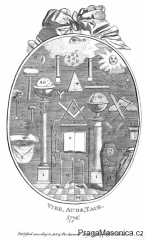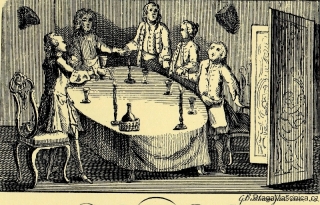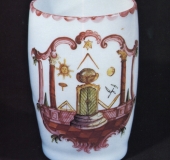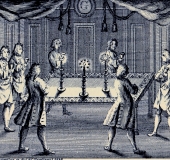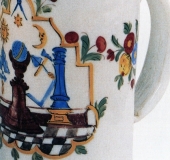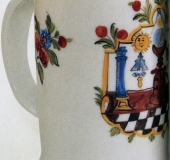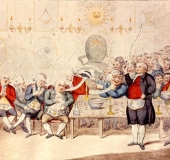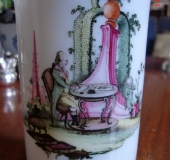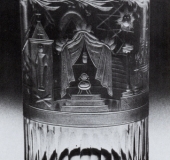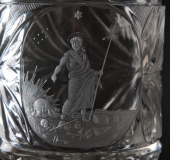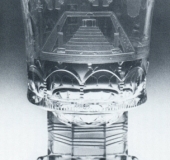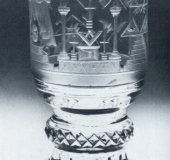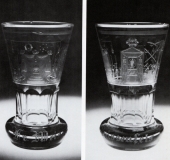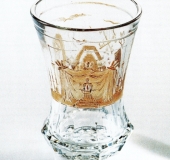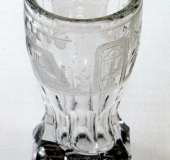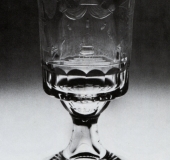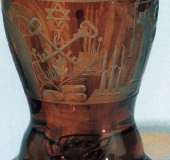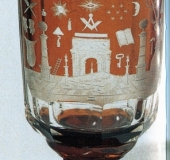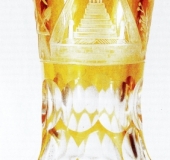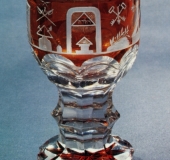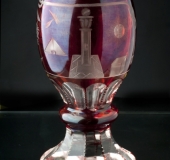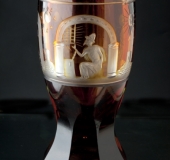Bohemian Masonic Glass.
Since its earliest days, Masonic lodges combined the ritual meetings with sociability. This took the form of jointly eating and drinking after the moral and philosophical teachings of the ritual. In the very early period the moralizing and toasting were intertwined, but later it became practice that the dinner, called festive board, would take after the lodge proceedings ended. Table rituals quickly developed around wine taking. Brethren would propose toasts to the King, Craft, Grand Master, Worshipful Master, Wardens, visitors etc. Glasses would be raised, emptied and subsequently lowered and this was followed by a three times three banging on the table. The glasses used for this occasion would be so called Firing glasses, which were small glasses with a strong and heavy bottom to withstand the table banging. This practice was not exclusively Masonic as taking fire and Firing glasses where common in military regiments and many other fraternal societies in England in the early decades of the 18th century. However, English lodges spread the practice of Masonic toasts and the use of firing glasses over the whole world. From the middle of the 18th century we see in England, Holland and Germany the firing glasses being decorated with masonic symbols, lodge names or numbers. This transformed the firing glass to a Masonic firing glass.
Bohemia has been throughout history a major glass producer and exporter. Not only would the production a glass itself take place at the many different glass factories around the country, but also the finishing by engraving or painting would take place there. As glass production was a commercial and export oriented business, it was only natural, that Masonic glasses would become part of glass goods produced and sold. In the last quarter of the 18th century we see the popular milk glass (milk-white glass) successfully produced and exported by the Neuwelt glass works at Harrachov in North Bohemia. Several milk glass beakers with masonic and enlightenment decorations are known from this period. After 1800 a standardized pattern of the masonic glass, sometimes called canon, was established. It is mostly a heavy glass, very often with a heavy bottom. The glass is than decorated with engraved masonic symbols. In is interesting to see, that these decorations follow a certain standardized pattern. It seem very likely, that the earliest engravers took the medallion published in 1776 as frontispiece decoration of the exposure Jachin and Boas as their model and inspiration. The early engravings follow precisely this medallion, which encompasses nearly all masonic symbols. However, in due course, it seems that one engraver copied another and so subsequently corrupted the symbols. This original standard set of masonic symbols developed from ca 1800 until ca 1930 into sometimes unrecognizable pictures, loosing thus the symbolic meaning and leaving only a decorative function. The tendency to develop large, elaborately formed and decorated glasses meant, that they gradually lost their original function as firing glasses for toasting and table banging. They assumed a more formal role like to be given to brethren to celebrate a Masonic jubilee or as a reward for fulfilling Masonic functions. In the 19th and beginning of the 20th century, a great volume of Masonic glasses was produced in Central Europe. This would cover Saxony, Thuringia, Silesia and Bohemia. As in this period there was a more or less free exchange of goods and labor, and all owners and managers of glass works in this area were German speakers, it is difficult to asses, which Masonic glasses came from Bohemia. A deep research into the archives of Bohemian glass factories is needed, to find orders, production plans and engraving proposals, to establish which glass work produced which Masonic canons. So far we know only, that in 1930 the glass factory in Tasice produced four big Masonic glasses according the design of the world famous artist Alfons Mucha. A bigger series was planned (7 or more) but unfortunately only four were made, probably in small numbers. The tradition of high quality Czech glass design has been revived after 2000 by the artist Petr Larva, who designed and produced a beautiful modern Masonic canon and a firing glass. © Jacob Sadilek References: Oberheide, J., Logengläser. Akademische Druck-u. Verlagsanstalt, Graz, 1983. Museum für Hamburgische Geschichte. Trinkgläser für Freimaurer. Figürliche Porzellane und andere Gebrauchsgegenstände, Hamburg, 2000,
Click on picture to enlarge and read explanatory text. All shown items are in private possession unless mentioned otherwise.

